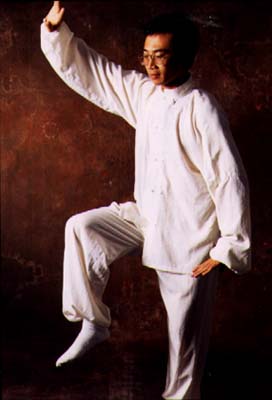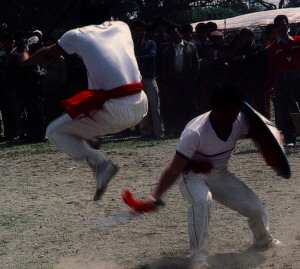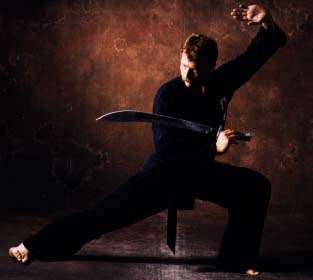
![]()
What is Gung Fu?
In dealing with the
recently popularized concept of Gung Fu, one must begin the
discussion by explaining
that Gung Fu is not a martial art unto itself, yet is
encompasses the most
effective and devastating methods of self-preservation
known to man. The identity
of Gung Fu is diverse; over 1,000 styles are known
or recognized. From
Gung Fu came Karate, Escrima, and most important, a way of
thinking that became
a code of life.
Gung Fu requires of
the practitioner a strict code of physical and mental
discipline, unparalleled
in Western pursuits. It is only as a whole concept
that Gung Fu can be
discussed, and this entails more than fighting.
To be adept, one must
follow the Tao, the way, the essence of the philosophy
and life of the originators
of the arts. One cannot pay to learn this art; it
is only acquired by
the desire to learn, the will to discipline one's self, and
devotion to practice.
The standards to be
met to attain proficiency are so high that the Chinese
refer to the master
as a disciple of the way of the tiger, the sign of the
dragon.

![]()
The Martial Aspects
The power of the Gung
Fu practitioner lay in his ability to defend himself
against impossible
odds and situations. After years of the most diligent
practice, these monks
became more than merely adept at the ways of survival.
But the initial acceptance
to be one of the chosen few was difficult.
As young boys, the applicant
for priesthood were made to do the most menial and
difficult work related
to the upkeep of their temple. Their sincerity and
ability to keep the
secrets of the order were severely tested for years before
the finer aspects of
the order were revealed to them. But, upon being accepted
by the elders of the
temple, his entry into Gung Fu was to open a whole new
world. He would work
long hours training mind and body to work together in a
coordinated effort.
He would learn the principles of combat, the way of the
Tao, and together they
would ensure his way to peace.
He would be taught initially
the first basic fist sets, the prearranged forms
which simulated multiple
attacks. These in turn became more complex as the
student advanced, while
he would simultaneously be learning the way of Taoism.
Upon completion of the
student stage, he became a disciple, who would be taught
the higher secrets
of the arts and philosophies. Weapons of all descriptions
would become familiar
to him as weapons of attack and defense. He would perfect
his movements to coincide
with his breathing. His mind would meld into the
realm of meditation
known as mindlessness. And he would learn to harness his
ch'i.
Ch'i is a concept of
such magnitude, so alien to the sterile western mind, that
we shall deal with
it throughout this site in many different lights. For now,
suffice it to say that
ch'i is the power governing the universal power, so to
speak. Only by harnessing
such energy can a person of mild stature learn to
break bricks with his
bare hand, or learn to sense the movements of an opponent
in the darkness. The
list of feats goes on and on; we shall discuss some of
these in other sections
of this site.
Essential to movements
in Gung Fu are ch'i-controlled actions. Compare the
movements of a Karateka
and a Gung Fu practitioner, and the differences are at
once obvious. The Karateka
moves deliberately, forcefully, each move unique and
distinct from each
other move. He punches linearly, kicks in a straight line,
and keeps his body
as rigid as iron. The Chinese boxer, on the other hand, is
smooth and fluid in
motion, allowing several moves to meld imperceptibly into
one long, graceful
action. In short, Gung Fu is fluid.
Ch'i properly coordinated
allows for fluidity. Consider a single drop of water.
Alone, it is harmless,
gentle, and powerless. But what on earth can withstand
the force of a tsunami?
The concept of ch'i is the same. By tapping into the
universal energies,
one increases one's abilities manifold. How can one damage
a Gung Fu practitioner,
when one is unable to strike and injure a body of
water?

![]()
Artistic Aspects
There can be little
doubt, after examining first hand the structure of Gung Fu,
that mastery of it
is indeed mastery of a fine art form. It requires a
tremendous amount of
background, information and disciplines, which would shame
our liberal-arts students.
The priests of old were adept in all of the
following: medicine,
music, art, weapons-making, religions, animal husbandry,
cartography, languages,
history, and of course, Gung Fu. The artist had to be
more than a fighting
machine, he had to know how, where and why to enter a
fight, and even of
greater importance, how to avoid conflict. Only with
"unbeatable" ability
of the priest was he secure enough not to need to fight.
There was a ranking
system of sorts used, beginner, disciple, and master. The
beginner (novice or
student level), was the menial servant. Only very crude
rudiments of Gung Fu
were in his domain. Disciples were in effect almost
priests, still having
to master themselves, but of the right mettle to carry
the traditions and
secrets of the Shaolin. The pinnacle of master was reached
by very few; it was
truly the achievement of a lifetime.
The primary obstacle
that a disciple had to pass to attain the priesthood was
the test for master
rank. Actually a series of oral and practical exams, they
culminated in the test
of the tunnel. The candidate was lead to a corridor
linked with the outside
world. In the corridor were booby-traps, all lethal,
all unpredictable.
The disciple had to pass all of these, for there was no
going back, no way
out but to succeed. Most never even began the journey; few
finished it. The adept
who passed the traps faced one last obstacle; a several
hundred pound urn filled
with burning iron filings. On each side of the urn was
an emblem, different
for each temple, usually of a dragon and a tiger. The urn
had to be moved with
the bare forearms to unblock the exit. In so doing, the
now priest was forever
branded as a Sil Lum monk.
Many priests just out
of the temple would wander about the country acting as
doctors, roving law
givers, and guardians of the poor. Some would return to the
temple then it was
their job to prepare the next generation of priests. Entry
was between ages five
and seven. Graduation was at the age of at least
twenty-two. And every
bit was part of a long, hard life.
The stylistic variations
within the Chinese martial arts are due to various
factors. First, some
priests were not content with one "truth", and engineered
improvements or variations
on the old standards. Some arts had their origin
from Indian exercises,
while others were influenced by Greek wrestling, and
equally unexpected
pursuits.
Secondly, the priests
were not all content as priests. Some went civilian and
taught parts of the
temple boxing, mixed with moves of their own. A man who
preferred the use of
one style of attack, i.e. claws, would build a whole
discipline around gouging,
claw-like attacks (Eagle Claw system).
Thirdly, the civilians
taught by priests would adapt what they needed in their
real lives. For this
reason, Southern Chinese preferred hand techniques with
stable stances, adaptable
to boats, while the Northern Chinese adapted almost
bizarre foot techniques,
flying kicks and wild sweeps.
With this in mind, let us now review the more important styles.
![]()